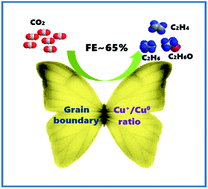当前位置:
X-MOL 学术
›
Green Chem.
›
论文详情
Our official English website, www.x-mol.net, welcomes your
feedback! (Note: you will need to create a separate account there.)
A strategy to control the grain boundary density and Cu+/Cu0 ratio of Cu-based catalysts for efficient electroreduction of CO2 to C2 products
Green Chemistry ( IF 9.3 ) Pub Date : 2020/02/13 , DOI: 10.1039/d0gc00247j Chunjun Chen 1, 2, 3, 4, 5 , Xiaofu Sun 1, 2, 3, 4, 5 , Xupeng Yan 1, 2, 3, 4, 5 , Yahui Wu 1, 2, 3, 4, 5 , Mingyang Liu 1, 2, 3, 4, 5 , Shuaishuai Liu 1, 2, 3, 4, 5 , Zhijuan Zhao 1, 2, 3, 4, 5 , Buxing Han 1, 2, 3, 4, 5
Green Chemistry ( IF 9.3 ) Pub Date : 2020/02/13 , DOI: 10.1039/d0gc00247j Chunjun Chen 1, 2, 3, 4, 5 , Xiaofu Sun 1, 2, 3, 4, 5 , Xupeng Yan 1, 2, 3, 4, 5 , Yahui Wu 1, 2, 3, 4, 5 , Mingyang Liu 1, 2, 3, 4, 5 , Shuaishuai Liu 1, 2, 3, 4, 5 , Zhijuan Zhao 1, 2, 3, 4, 5 , Buxing Han 1, 2, 3, 4, 5
Affiliation

|
Cu(OH)2/CuO nanocomposite-derived Cu2O/Cu was highly efficient for CO2 electroreduction to C2 products. The highest faradaic efficiency and current density could reach 64.5% and 26.2 mA cm−2, respectively. By changing the calcination time, moderate grain boundary density and the Cu+/Cu0 ratio in catalysts can be controlled, leading to a large number of active sites and low interfacial charge transfer resistance.
中文翻译:

控制铜基催化剂的晶界密度和Cu + / Cu0比的策略,以有效地将CO2电还原为C2产品
Cu(OH)2 / CuO纳米复合材料衍生的Cu 2 O / Cu对于将CO 2电还原为C2产品非常有效。最高法拉第效率和电流密度分别可以达到64.5%和26.2 mA cm -2。通过改变煅烧时间,可以控制适度的晶界密度和催化剂中的Cu + / Cu 0比,从而导致大量的活性位点和较低的界面电荷转移阻力。
更新日期:2020-03-09
中文翻译:

控制铜基催化剂的晶界密度和Cu + / Cu0比的策略,以有效地将CO2电还原为C2产品
Cu(OH)2 / CuO纳米复合材料衍生的Cu 2 O / Cu对于将CO 2电还原为C2产品非常有效。最高法拉第效率和电流密度分别可以达到64.5%和26.2 mA cm -2。通过改变煅烧时间,可以控制适度的晶界密度和催化剂中的Cu + / Cu 0比,从而导致大量的活性位点和较低的界面电荷转移阻力。











































 京公网安备 11010802027423号
京公网安备 11010802027423号